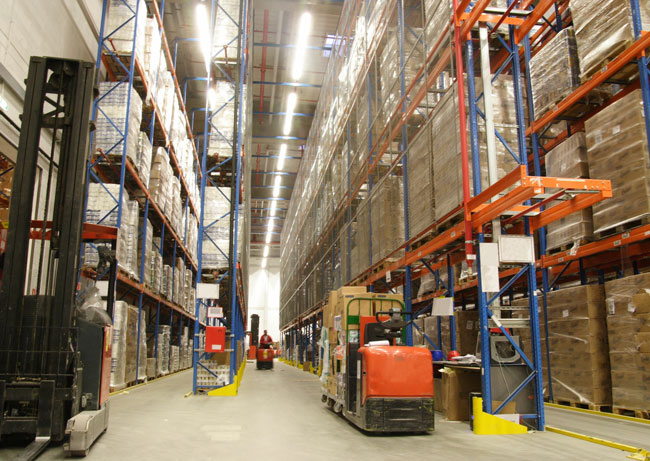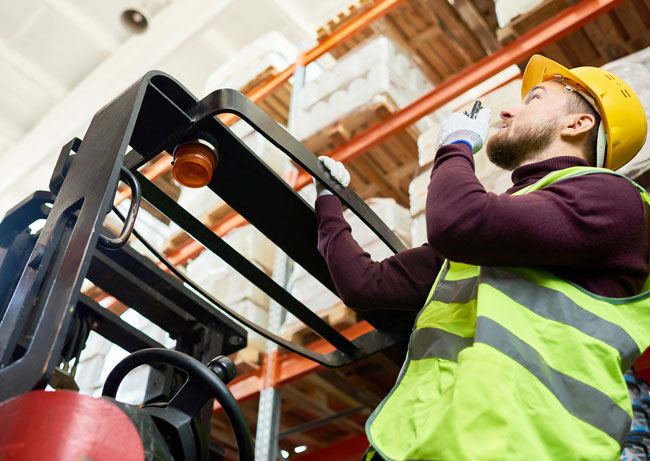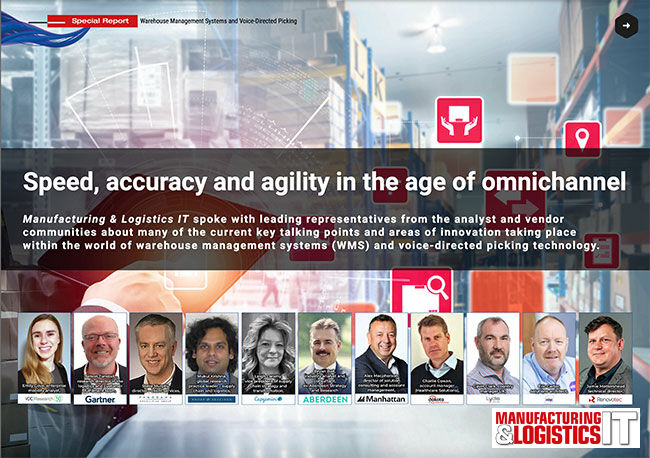Manufacturing & Logistics IT spoke with leading representatives from the analyst and vendor communities about many of the current key talking points and areas of innovation taking place within the world of warehouse management systems (WMS) and voice-directed picking technology.
 With dominant supply trends such as omnichannel, solutions providers have had to up their game, as have warehouse professionals who need to ensure they are more integrated, faster reacting and more accurate than ever before.
With dominant supply trends such as omnichannel, solutions providers have had to up their game, as have warehouse professionals who need to ensure they are more integrated, faster reacting and more accurate than ever before.
So, what are the current key talking points and/or innovations/developments in the voice-directed picking and warehouse management solutions space?
In terms of workforce trends driving the adoption of voice and upgrades to WMS, Emily Gove, enterprise mobility analyst, VDC Research, maintains that workflow optimisation and ease of use remain top concerns for mobility leaders in these spaces. “More enterprises are seeing the benefits of voice in warehousing, distribution and logistics environments,” she says.
“VDC has forecast a 5-year growth rate of over 6% for voice-dedicated software and hardware (2022-2027). Overall, investments in voice-directed solutions for workflows like picking, packing, put-away or MRO have resulted in a 10-30% increase in worker productivity.” Gove adds that, considering the technology itself, voice solutions are becoming nimbler. “Where initially, a voice solution might mirror typical picking workflows, voice now integrates with AMRs and warehouse execution systems (WES),” she explains.
In terms of drivers for these changes and developments, Gove makes the point that for the past two years, organisations have operated with a constrained labour force. “This was initially triggered by pandemic social distancing and increased worker absence due to contagion,” she points out. “Between 2021-22, heightened resignation levels across industries exacerbated an already weakened labour pool. Organisations that employed voice picking did so to speed up onboarding processes and enable hands-free workflow for current workers, improving worker productivity. In the current environment of rising operating costs and inflation, enterprise mobility leaders are now focused on maintaining productivity among workers.”
Have ways of best integrating voice-directed systems with other systems developed to any notable degree over the past year or two?
Gove reflects that voice solutions have been challenging to deploy and integrate with existing enterprise applications (WMS, ERP, WES, etc.). “This has been a point of emphasis for many of the leading solution providers as they have invested in developing pre-built integrations to many of the leading host systems (SAP, Manhattan, Blue Yonder, etc.),” she says. “In addition, development kits that can be used to custom code a connection with virtually any host have been vastly simplified. Another development has been around improvements of speaker independent solutions. While these have been unreliable with high levels of word error rates newer solutions also includes the option to train words, making them more reliable and viable for industrial applications.”
Gove adds that one challenge is still the age of the enterprise applications with which the voice system interfaces. “The older the platform the more challenging the integration and longer time to value,” she says. “While organisations have typically viewed supply chain environments as cost centres where upgrade investments are pushed out until they become critical, the supply chain challenges faced over the past 24-36 months have created a sense of urgency with organisations prioritising modernisation investments. Recent research conducted by VDC showed that the share of organisations running the ‘most current’ WMS version jumped from 30% in 2021 to over 40% in 2023.”
Composable architectures
 Simon Tunstall, research director in the logistics and customer fulfilment team, Gartner, says it is an exciting time to be monitoring warehousing technologies because there will likely be more developments in this space over the next five years than there have been over the past 20. “At Gartner, we are seeing three key drivers behind the technology changes within WMS,” he explains. “The first relates to the fact that many organisations are getting tired of the costly and resource- and time-hungry upgrades, together with constrained adaptability. If you have to upgrade your WMS every few years it’s quite an expense, and when companies buy a WMS they typically keep it for quite a long time. Therefore, we’ve seen quite a trend from the WMS vendors towards more modern, composable architectures such as micro services. Some vendors offer this already, while others are on a longer journey.”
Simon Tunstall, research director in the logistics and customer fulfilment team, Gartner, says it is an exciting time to be monitoring warehousing technologies because there will likely be more developments in this space over the next five years than there have been over the past 20. “At Gartner, we are seeing three key drivers behind the technology changes within WMS,” he explains. “The first relates to the fact that many organisations are getting tired of the costly and resource- and time-hungry upgrades, together with constrained adaptability. If you have to upgrade your WMS every few years it’s quite an expense, and when companies buy a WMS they typically keep it for quite a long time. Therefore, we’ve seen quite a trend from the WMS vendors towards more modern, composable architectures such as micro services. Some vendors offer this already, while others are on a longer journey.”
Tunstall explains that some micro services are based on multitenant cloud. “One advantage here is the ease of upgrades because you’re not modifying the code and some companies want to move towards zero downtime upgrades,” he says. “However, if you’re working in a high-complexity environment there is still quite a lot of effort to implement the system in the first place, so the main benefit does seem to be on the upgrade side not necessarily so much on the initial implementation.” With the same driver, Tunstall has seen more focus on user experience and tools to aid implementation and integration from WMS vendors and from elsewhere.
Labour, space and capital constraints
Tunstall adds that there have been, and continue to be, constraints on labour. “This is particularly the case in Western Europe and North America, but it also remains an issue in other regions of the world,” he says. “For some companies, operating space is an issue, as are constraints around capital. These factors are pushing some organisations to look for alternative approaches for both people-driven and automated environments.”
 Steve Murphy, director – client services, Panorama Consulting Group, reflects that WMS has come a long way over the past decade or so. “It used to be the case that when a company received purchase orders somebody would hand key information into the system,” he reminds us. “Now, as is the case with ERP systems, the speed of information flow has created a whole new level of data access speed and accuracy, with the data moving fast and goods moving quicker from receiving a purchase order through to moving through various locations to the stock location or shipping to a customer.”
Steve Murphy, director – client services, Panorama Consulting Group, reflects that WMS has come a long way over the past decade or so. “It used to be the case that when a company received purchase orders somebody would hand key information into the system,” he reminds us. “Now, as is the case with ERP systems, the speed of information flow has created a whole new level of data access speed and accuracy, with the data moving fast and goods moving quicker from receiving a purchase order through to moving through various locations to the stock location or shipping to a customer.”
Murphy adds that there has also been a major evolution in barcode reading. “Some 25 years ago it was pretty basic. Now, with modern tracking systems, you put goods on the conveyor system and the RFID reads the information as they move through the system. Then, when goods reach the stage of being loaded onto a truck, the RFID moves from the warehouse location to the truck location and you can track that information as it moves from, say, San Diego through Las Vegas, through Denver all the way to New York City. This whole technological advance in inventory management has just been truly impressive over the past few years and continues to move forward.”
Refined language capabilities
In the case of voice picking. Murphy asks who would have thought that this would be a reality a few years ago? “Now, the voice systems have even more refined language dialect capabilities, which make them more and more user friendly.” Murphy also points out that robotics are becoming more commonly used within warehouses. “Some believed this move to greater automation would take people’s jobs, but it hasn’t really been the case. In fact, automation is helping people be more efficient and quicker at what they do. The deployment of robotics and automation will continue to develop, and I think it’s an exciting next step.”
Murphy also explains that there is now technology that can help companies to design the layout of their warehouse in a more automated way, which is much better and faster than how it was done manually. “Technology can now help companies to design where they should put their highest moving products and ensure the most convenient point of access,” he says. “In addition, there is always the drive to reduce inventory and improve visibility. With today’s warehouse management systems, companies now have the ability to do that in an almost real-time manner. So, when something comes through the door to the receiving dock, a mobile device can be used to read the barcode on the package and know it came from a particular vendor on this PO to a certain quantity, and this is the location it needs to be stored at.
A company may have AGVs to put the goods away or rely on warehouse staff to put the goods away manually. However, whatever the method, a wave of put away can be designed to be the most effective and efficient for the company’s needs. This can increase productivity from the get-go. Similarly, pick waves can be designed so they are the most effective and efficient ways to pick the products. Companies also have the visibility to communicate to their customers that goods have been picked and that they are leaving the warehouse today at a certain time and provide an anticipated delivery time.”
According to Murphy, recent drivers for change include the effects of the pandemic on the supply chain, with the subsequent growth in ordering online and the development of omnichannel and the need for more flexible inventory management where goods can be shipped efficiently both to physical stores or direct to consumers’ homes. Murphy believes modern warehouse management systems’ ability to automate those functions and processes within the warehouse has been of key importance here.
Worker retention
 Mukul Krishna. global research practice leader – supply chain and logistics, Frost & Sullivan, reflects that when the pandemic hit, and especially in the wake of the pandemic, there was a trend for ‘big quitting’ where many people left picking jobs in warehouses to upskill or reskill themselves to get into the gig economy. He makes the point that, since then, it has been an ongoing challenge for companies to keep warehouse activity to an efficient level. “No one is even close to getting to a dark warehouse where most things are fully automated,” he says. “It’s just not there, so workers in the warehouse remain critically important.”
Mukul Krishna. global research practice leader – supply chain and logistics, Frost & Sullivan, reflects that when the pandemic hit, and especially in the wake of the pandemic, there was a trend for ‘big quitting’ where many people left picking jobs in warehouses to upskill or reskill themselves to get into the gig economy. He makes the point that, since then, it has been an ongoing challenge for companies to keep warehouse activity to an efficient level. “No one is even close to getting to a dark warehouse where most things are fully automated,” he says. “It’s just not there, so workers in the warehouse remain critically important.”
So, if companies are falling short of workers, Krishna explains that they need more temporary workers. He also believes they need to think even more about worker safety because warehouses are becoming larger, and companies don’t want any litigation due to employees tripping and injuring themselves. “So, when you take all of that together, voice-directed picking is no longer a ‘nice to have’ anymore, it’s a ‘must have’, especially for larger warehouses and DCs,” he says. “In fact, it’s not just on the warehouse side, there are also areas such as cross docking where this technology is important.
Of course, we have known for some time that voice directed picking solutions can increase accuracy by a magnitude, and that it can create fewer errors, make for much happier workers and customers, cut costs and so on. All these benefits are well-known parts of the value proposition. However, what people sometimes don’t appreciate is that as voice solutions become increasingly popular, they need to bear in mind that they will have a workforce with diverse linguistic needs. The good news is that many voice systems now have the functionality to give instructions not only in multiple languages but in some instances also in regional accents and dialects.”
Krishna adds that another trend he monitored through the pandemic was many new e-commerce customers. “This wasn’t just on the business-to-business side, far more business-to-consumer shoppers also started to buy online and largely stayed online. So, the volume of online sales has gone up since pre-pandemic. Therefore, within the warehouse fulfilment centre the requirement for pickers has not fallen off – if anything it has increased.” Also, with more and more people having left that type of job to go into other professions, Krishna points out that there has been a need to figure out A how to be more efficient and B how to be more accurate. “This is because it’s not just about the cost of shipping something incorrectly, it’s also the cost of managing returns – the reverse logistics. In addition, operational efficiency is key when we are looking in certain areas, especially within the EU where there is a major focus on ESG requirements and sustainability.”
Troubleshooting
 Leigh Laramy, vice president of supply chain strategy and transformation, Capgemini Invent, highlights the fact that organisations are increasingly integrating chat bots into their warehouse management solutions. “This is helping provide those on the warehouse floor an easy access tool to navigate databases and source information, such as training materials, or quickly troubleshoot any issues they may be having along their pick walk,” she says. “However, we’re already seeing this approach taken further with the application of artificially intelligent voice assistants, such as Amazon’s Alexa.
Leigh Laramy, vice president of supply chain strategy and transformation, Capgemini Invent, highlights the fact that organisations are increasingly integrating chat bots into their warehouse management solutions. “This is helping provide those on the warehouse floor an easy access tool to navigate databases and source information, such as training materials, or quickly troubleshoot any issues they may be having along their pick walk,” she says. “However, we’re already seeing this approach taken further with the application of artificially intelligent voice assistants, such as Amazon’s Alexa.
This technology can be integrated into voice-directed picking solutions, providing more intuitive and instant access to required information – all available through voice commands using the employee’s headset. In doing so, new possibilities can be unlocked for voice-directed picking, enabling greater efficiency and overall warehouse performance.”
As to the drivers behind these developments, Laramy points out that the pandemic spearheaded the pace of innovation for warehouse management, as there was a need to quickly mobilise workforces to serve the growing consumer demand for online deliveries. She adds that, combined with the ongoing supply chain disruptions, maximising warehouse efficiency has been paramount. “The benefit of voice technology is that it can be multilingual – accommodating for any languages spoken by employees,” she explains. “Not only is this inclusive of the diverse workforce warehouses can comprise of, but it enables workers to undergo training in their native language and carry this onto the warehouse floor in their daily tasks.”
Laramy makes the point that the rise of robotics and AI-assisted machinery within warehouses has also been a key development within WMS. “The possible use cases for robotics are ever evolving, and combining with voice technologies can unlock a more robust warehouse management ecosystem for providing instant access to information and elevating employee efficiency,” she says.
The power of the consumer
 Bryan Ball, industry analyst and consultant, ex-Aberdeen Strategy and Research, states that, today, the omnichannel framework is driving behaviour in the supply chain. “It’s all about speed and customer satisfaction,” he says. “More people are now shopping online. This was a trend that really took off during the pandemic and now many people are unwilling to give up the habit of ordering online. That said, clearly some people have returned to the stores but not in the volumes they were pre-pandemic. Since then, more consumers have realised the power they have. No longer do they have to show up early for a retail store’s sales event on a Thursday to pick up some bargains.
Bryan Ball, industry analyst and consultant, ex-Aberdeen Strategy and Research, states that, today, the omnichannel framework is driving behaviour in the supply chain. “It’s all about speed and customer satisfaction,” he says. “More people are now shopping online. This was a trend that really took off during the pandemic and now many people are unwilling to give up the habit of ordering online. That said, clearly some people have returned to the stores but not in the volumes they were pre-pandemic. Since then, more consumers have realised the power they have. No longer do they have to show up early for a retail store’s sales event on a Thursday to pick up some bargains.
Now, they can search online for a product offered by different outlets at different prices or choose from a range of similar products and make a purchase within a few seconds with same next-day or even same-day delivery in some cases. The level of consumer power and sophistication has gone way up. So, given that new reality businesses have realised that omnichannel means the brands can’t define the rules so much anymore. Because of this, they’re having to shift to satisfying the consumer on omnichannel terms.”
Ball adds that one of the functionality fundamentals is many companies’ WMS isn’t tightly integrated with their order management system. “They might pass the information from the order management system to the WMS, it might be in a batch, and they drop all the orders on the floor for people to pick them and get them out the door. Now, with omnichannel, companies need to integrate these systems more closely. In the 1980s it was a month’s supply, in the ’90s it was week’s supply, in the late ’90s and early 2000s it was day’s supply. Then, it even started to move from next-day to same-day delivery. The point is that the speed in which companies need to respond is largely due to online customers. So, they’ve got to find a way to work quicker because the omnichannel framework is driving consumer behaviour. Therefore, companies now need to connect the order management systems with the execution systems.”
Ball believes that to truly understand your customers, you have to deal with multiple touch points. “Before Covid, it was largely about the shopping experience, meaning what are customers’ preferences and what types of products do they more regularly click on. It was all about making things attractive to them based on how they shop. All of a sudden, this expanded to ensuring customers get their products when they want them and in the form they want then, whether it’s in a certain type of packaging or even the best point to delivery it at your house, for example at your front door as opposed to leaving it by the garage door round the back. There can be a disconnect here between customer feedback and execution. Here, companies also need to be aware of the power of social media, where they might receive a positive or negative review online if they don’t provide the very best customer service. At the end of the day, customers could shop with someone else if they don’t receive the service they demand from their current provider. This is the level of sophistication to which consumers have involved.”
However, returning to the fundamentals, Ball explains that the order management and execution systems haven’t traditionally been on the same platform. “So, the need to get these systems on the same platform in order to drop orders almost instantaneously and in some cases make same-day delivery is now really the key to providing an efficient omnichannel service. Some companies may have done this in the past by integrating their e-commerce system with their order management system, but in many cases the brands were a little disconnected because they still thought they were in charge as opposed to the customers. Now, I think they need to do things to retain or recapture their customers.”
Pressure to update
Ball makes the point that if you do have those things tightly coupled and that the WMS can execute at the level the order management system is demanding, maybe for same-day delivery, then you’re ahead of the curve. “In the US, to some extent in the UK and indeed in some other territories, many established companies have had software in place for many years. The original packages might have been installed back around Y2K at the beginning of the century, with regular upgrades ever since. Here, some newer companies could have an advantage because they would have started up with more modern systems straight away. They can operate in a more seamless way than companies still relying on older code and older systems. So, because these newer companies can be much more agile there’s a lot of pressure on the older companies to update and to operate efficiently to compete efficiently in this new omnichannel world.”
Ball believes another important point to make is that with a multinational workforce in the warehouse, systems used such as voice directed picking need to be multilanguage and multicurrency, particularly if you’re shipping all over the world. He adds that the good news is, today, many voice systems do provide this level of functionality.
Unified and joined up systems
Alex Macpherson, director of solution consulting and account management, Manhattan Associates, makes the point that there is now a greater level of unified and joined up systems within the four walls of the warehouse. As an example, he cites Manhattan Associates’ Yard Management offering, which joins the warehouse to the yard and to transportation management. According to Macpherson, a key driver for this development is the need to join up and unify processes/stages within the supply chain.
Charlie Cowan, account manager (Healthcare Solutions), Dakota, makes the point that, as well as their well-established use in the warehouse for picking and replenishment, voice-directed data capture solutions are fast becoming a popular choice within a variety of maintenance and inspection environments.
Dakota provides Honeywell Voice solutions that are purpose-built for the maintenance and inspection marketplace, enabling companies operating within industry sectors such as rail, automotive, manufacturing and aerospace to run a better and more compliant business with voice. Other state-of-the-art developments cited by Cowan include Honeywell’s Soundsense technology for headsets and the use of accelerometers within healthcare for vibration monitoring etc.
 Cowan also references Voice-Care, an application developed specifically for the healthcare sector, designed to progressively transform patient safety and care. Allowing users to work totally hands and eyes free, Voice-Care is an easy to use, low-cost digital solution that addresses the need to simplify the recording of patient observations directly from the bedside in real time.
Cowan also references Voice-Care, an application developed specifically for the healthcare sector, designed to progressively transform patient safety and care. Allowing users to work totally hands and eyes free, Voice-Care is an easy to use, low-cost digital solution that addresses the need to simplify the recording of patient observations directly from the bedside in real time.
Increased online sales demand
According to Cowan, one of the main drivers for these developments has been the pandemic, which increased the demand for online sales, which remains above pre-pandemic levels. Another key driver, according to Cowan, has been Brexit and the labour shortage. Added to these drivers is the operational cost savings afforded by these technological developments.
Gavin Clark, country manager UK, EPG (Ehrhardt Partner Group), makes the point that almost all companies are currently struggling to find and retain sufficient numbers of suitable skilled workers. “Jobs in logistics are tough and not always particularly attractive,” he says. At EPG, we aim not only to optimise processes with our solutions and make them more efficient, but also to make jobs more innovative and attractive. This also applies to pick by voice solutions. They must be easy to integrate, but also reliable in voice recognition, intuitive to operate, and the software and hardware must be particularly reliable and user-friendly. Also, we want voice to be fun to work with.”
 Clark believes good technologies are key for employee satisfaction. “Studies show that staff are more likely to stick with an employer if they are able to work with technologies that they enjoy using,” he says. “By delivering a high-performance and user-attractive overall solution, we also help our customers to better meet the current challenges and retain their staff in the long term.”
Clark believes good technologies are key for employee satisfaction. “Studies show that staff are more likely to stick with an employer if they are able to work with technologies that they enjoy using,” he says. “By delivering a high-performance and user-attractive overall solution, we also help our customers to better meet the current challenges and retain their staff in the long term.”
In terms of drivers for these developments, Clark explains that across nearly all distribution centres he meets people of many different nationalities. “Many of them don’t speak English fluently or have strong accents. With the right voice system, even non-native speakers can be up and running very quickly. LYDIA Voice not only recognises every speaker without prior voice template training. With the latest release, LYDIA even speaks and understands multiple languages simultaneously. An absolute game changer for multinational teams. Ukrainian is a language that is currently in great demand in many countries. LYDIA Voice helps to offer war refugees a new perspective and to integrate them quickly into everyday working life in the warehouse – even if they still speak almost no English, yet.”
 According to Eric Carter, solutions architect, Indigo Software, one question we all need to ask the industry is why are paper and pen still being used in warehouses – especially considering how the Android operating system has made mobile working in the warehouse so accessible for any business. “A high percentage of mobile devices use Android, and this includes voice headsets,” he explains. “Much of the voice kit previously available is highly proprietary and also very expensive in comparison. Now the use of Android with Google’s voice recognition capabilities means it has become easy (and potentially cheap) to develop and implement voice applications.
According to Eric Carter, solutions architect, Indigo Software, one question we all need to ask the industry is why are paper and pen still being used in warehouses – especially considering how the Android operating system has made mobile working in the warehouse so accessible for any business. “A high percentage of mobile devices use Android, and this includes voice headsets,” he explains. “Much of the voice kit previously available is highly proprietary and also very expensive in comparison. Now the use of Android with Google’s voice recognition capabilities means it has become easy (and potentially cheap) to develop and implement voice applications.
“The point is that all these systems have their place in a warehouse. The traditional proprietary voice systems are extremely robust and powerful, but they come at a high price. They can be too costly for up to 50% of small businesses with 20 or fewer pickers. Android devices have changed all that and will help to make voice mainstream. It’s extremely good for the industry because companies may adopt voice as part of an initial implementation raising awareness of the wider benefits of software driven warehousing.”
Cutting implementation times
With regard to drivers for these developments, Carter says he is finding that as a result of continuing economic instability, many companies are reacting to circumstances rather than planning ahead strategically. “This is happening for numerous reasons including the situation in Ukraine, but now this lack of planning is creating problems. It is making companies explore ways to get more rapid results and to short cut WMS implementations into a matter of weeks. Indigo QuickStart is ideally placed to satisfy this demand and at the same time, provide a clear upgrade path in the future as warehouse management priorities change.
“The demography of the warehouse and logistics industry is changing, and a new generation of management is taking control. This group grew up with technology and their expectations of process efficiency are very different, creating many more opportunities for solution providers in the voice and WMS marketplace to replace old fashioned, paper-based systems.”
Carter makes the point that the voice market has really matured and now there are voice products targeting every end of the customer spectrum, based on an acceptance that not every company can justify the spend that high end voice systems are commanding and will continue to command. “Overall, the market has broadened and become more commoditised,” he says. “There are businesses that want ‘cheap and cheerful’, plus others that will only purchase ‘all-singing-all-dancing’ systems. Both deliver a fantastic return on investment. Just as handheld mobile terminals used for picking became mainstream and operatives take this way of working for granted now, voice is transitioning to the same level of critical mass.
“This mass adoption has come at just the right time because there are significant staff shortages following the Covid pandemic and Brexit. Added to this is the upwards trend in salary expectations within the warehousing arena. Companies are competing for workers anyway and inflation is adding to the trend.”
Adaptive recognition
 Jamie Mottershead technical director, Renovotec, reflects that voice technology is constantly evolving to take advantage of small improvements that can improve productivity, accuracy and the user experience but fundamentally the focus will always be on recognition. “Whether you use a trained or untrained voice solution, the moment you must repeat a command due to a recognition issue you will lose any productivity gains at that point in the process,” he says. “Technology enhancements such as adaptive recognition allows the voice solution to ‘learn’ how you speak and constantly update trained voice templates.
Jamie Mottershead technical director, Renovotec, reflects that voice technology is constantly evolving to take advantage of small improvements that can improve productivity, accuracy and the user experience but fundamentally the focus will always be on recognition. “Whether you use a trained or untrained voice solution, the moment you must repeat a command due to a recognition issue you will lose any productivity gains at that point in the process,” he says. “Technology enhancements such as adaptive recognition allows the voice solution to ‘learn’ how you speak and constantly update trained voice templates.
A hybrid approach combining non trained voice solution with the ability to train words that an operator may have difficulty with is a flexible approach that can help with nonnative speakers. Enhancements to headset technology that can cut our insertions (background noises) that could be interpreted by the recogniser as speech add to the productivity and accuracy benefits.”
According to Mottershead, voice technology has been influenced by multiple factors and continues to be flexible in adjusting to ever changing consumer demand. “Operations are constantly fighting a battle over the lack of skilled labour, a non-trained voice solution ‘Pick Up and Go’ means less initial training i.e. removing the template training, meaning the operator is up and running quicker. Combine that with a trainable pick up and go a solution that can train issue words or commands and you have solution that can resolve all potential recognition challenges. A flexible voice solution should also allow for a ‘new starter’ workflow that would include additional dialogue/commands which would guide the operator through the process once the operator is more comfortable/confident they would then move to the enhanced workflow.”
Integration
Have ways of integrating voice systems with other systems like ERP, WMS, and so on, developed to any notable degree over the past year or two?
Where possible, a voice solution should always use a direct connection to the WMS, says Mottershead. “This minimises the need for making changes in multiple places in the future. This is not always possible however and the need to use middleware can be the best option in some cases, this option can allow for additional process improvements such as linking and merging orders together to be picked at once.
This option is used when this functionality is not available in the WMS/ERP. When a good process already exists, there is the option to communicate directly with a screen, holding a screen at a server level in emulation can be a way of implementing voice with little to no development from the host solution. Deciding on the best integration method will involve understanding the operation as well as the WMS/ERP capability but is crucial to being able to deliver the best possible voice solution.”
Carter explains it is now more common to have multiple integrations with lots of different systems including legacy ERPs that may be very elderly. “Companies are exploiting more modern integration techniques to make the interactions between the different systems more seamless,” he says.
Cowan makes the point that Dakota voice middleware can integrate into any WMS or ERP. He adds that there are more direct connections available but they are limited in terms of functionality. Cowan also explains that there are always on-going developments in middleware to add additional functionality. He adds that within healthcare there is a trend for integrating other applications into the total solution. As an example, he cites Imprivata OneSign, a single sign-on (SSO) solution that enables clinicians to spend less time on technology and more time with patients. By eliminating the need to repeatedly type usernames and passwords, Imprivata OneSign allows clinicians to access clinical and administrative applications quickly and securely. This streamlines clinical workflows and drives EHR adoption.
Krishna considers that if you’re still largely proprietary as a provider of solutions such as voice directed picking or WMS, you’re ‘dead on arrival’. He believes companies in warehousing today just don’t have the time to go through complex and difficult integration processes when it comes to integrating solutions such as voice directed picking and WMS. “Also, today most devices are based on Android, so you need to have something that is open and can easily integrate with various systems, in many instances working in a hybrid environment that is both on premise and cloud.”

Cloud
Has the Software as a Service (SaaS) model, and cloud computing in general, had any notable level of impact on the voice-directed systems or WMS market?
Absolutely, says Clark. “Circumstances such as the pandemic, the shortage of skilled workers and the current trends in the logistics market mean that logistics companies have to be as flexible as possible. At the same time, however, they have become more reluctant to make major investments. EPG also offers a model where the customer can receive software, hardware, cloud hosting and all services as a rental model. We are noticing that the demand for SaaS is increasing more and more. With SaaS models, a particularly fast ROI can be realised within a few months, especially in the voice sector, without any great risk. In addition, the customer gets an all-round worry-free package if desired.”
According to Macpherson, SaaS, and especially microservices architecture, has fundamentally changed the way customers now think about their entire supply chains. “The expectation for agility, flexibility and innovation is so much higher today than it was even five years ago,” he says.
Within the UK market. Mottershead considers that the move to cloud-based SaaS model has been slower than expected. “What we are now seeing is the tier one WMS providers are offering this model as standard with their latest products. This leads to improvements in keeping everyone on the latest versions of software leading to improvements in voice, as often voice upgrades to the latest voice task or firmware can be delayed.”
Cowan considers that SaaS hasn’t have so much of an impact within the voice sphere. “Customers still prefer a perpetual licence model,” he says, adding that return on investment is strong with payback typically within 12 to 18 months. Cowan points out that more customers are moving to a cloud-based infrastructure, although this doesn’t impact voice solutions. He explains that voice has been designed to integrated with on-premise or cloud-based WMS/ERP. “The voice software can also be run on-premise or in the cloud. This can sometimes make it easier to diagnose any potential issues, with easier access and greater visibility to a wider team.”
Security and privacy
Carter considers that companies who are using a pure cloud model are always concerned with the implications of issues such as data security and privacy, versus having the security and peace of mind that comes with having an on-premise solution. “There are issues with any SaaS model,” he says. “These include performance challenges, high network dependency, plus a lack of knowledge and expertise because cloud computing professionals are very sought after and in high demand. Users are realising that cloud-based WMS systems are not the panacea that some people positioned them as a few years ago and can work out expensive over the long term. The most forward-thinking vendors are offering their customers the choice of both, depending on individual needs and circumstances.”
Krishna considers that the cloud today is a very valuable resource. “However, what people are finding now, especially when time is of the essence, is it comes down to the laws of physics. If I’m sending something to the cloud it’s going to take time to arrive. Even if data travels across fibre optic cables it still needs to travel over distance and come back. Valuable time is being taken away and you don’t know how far away the servers are. OK, many people don’t need data in real-time or close to real-time, but we’re seeing more and more people being increasingly interested in the capabilities of edge computing. Indeed, this becomes even more important where you have humans working with inventory management robots and things like that because inventory management robots are essentially edge servers on wheels with RFID sensors and machine vision.”
Murphy believes that in today’s immediate gratification world many of us don’t want to make an enquiry online and then have to wait even 5, 10 or 15 seconds for a reply. “Many cloud providers are aware of this and want to be close to, or even ahead of, where leading vendors such as Oracle, Microsoft Azure or Google are,” he says. “So, they’re trying to work out the next best thing. They may be using AI in this area to build fast networks, but whatever they are using to make improvements they’re making tremendous progress. Everything we’re seeing points to companies such as Google, Microsoft Azure and Oracle doing everything they can to stay ahead of the curve. Although some latency might sometimes be experienced, I think for the most part the cloud is as fast or even faster than on premise solutions.”
Gove considers that supply chain enterprise software has typically lagged other enterprise applications in its migration to cloud or subscription-based adoption models. “This is changing as customers today expect the option of both on-prem perpetual license (with maintenance) and subscription-based options,” she says. “While adoption of subscription-based solutions will be higher we do not see a massive near-term shift to that model for voice directed systems/applications.”
Laramy considers that Software as a Service (SaaS) models and cloud computing is enabling scalability, particularly from a cost ownership perspective. “For instance, an organisation could have multiple warehouses, each with their own bespoke requirements which may previously have required multiple on-prem solutions,” she says. “The associated cost barrier from this may have made such technologies inaccessible for many organisations. However, SaaS enables a more cost-efficient approach which can also be tailored to individual warehouse needs – enabling greater flexibility and wider adoption for innovative voice-directed systems or WMS technologies.”

Mobile solutions
Are mobile computers and tablet PCs etc. having an impact or influence on voice systems?
Mottershead points out that voice naturally fits well with mobile computers and tablets. “Running a voice solution on a ‘multimodal’ device isn’t new. What is important is implementing the right technology/solution for the task, using a multimodal device that is capable of displaying detailed information that then can be used to make decisions can be crucial. What shouldn’t be discounted is the option of integrating the data that is needed to make the decision into the voice solution. For example, a field-based inspection process might need additional information to handle an exception. This information could be requested and voiced to the operator or shown on screen, removing the need to move between applications.”
Cowan comments that in the warehouse/DC space the norm is still dedicated voice devices due to their ruggedness over mobile computers, with their ability to reducing downtime and cause fewer distractions than is the case with screen interaction. Cowan believes the growth of mobile computers and tablets with voice applications is in Maintenance & Inspection due to:
- 4g/5g for field service sending data back and forth
- Screen to see additional information, pull down schematics or documents etc
- Camera to take pictures
Gove sees greater modularity of voice solutions and a disaggregation of hardware and software. “Voice-based applications and workflows are designed to run on any mobile platform including Android and iOS and generally migrating away from legacy fully integrated solutions,” she explains. “While voice-directed solutions benefit certain workflows (repetitive labour-intensive workflows) it is not suitable for any application, so the need to support multi-modal interfaces and data collection options is required.” Gove is also seeing growing interest in combining voice with heads-up displays for vision-based solutions in addition to integrating voice with AMRs to drive incremental productivity improvements. “These are mostly in the POC phase and have not yet reached commercial maturity,” she points out.
Clark considers that voice technology can be easily combined with other technologies and smart devices. “Depending on the use case, this makes perfect sense,” he says. “For instance, some of our customers use mobile devices with a display to show additional item data, removal or packing instructions. This could be a tablet, or a smartwatch, for example. If we move away from the typical pick-by-voice applications in warehouses and distribution centres, there are many other industries and use cases where a combination with display devices or other smart devices makes perfect sense. For example, all kinds of checklist/inspection processes are currently a big topic.
In many inspection processes in industry and maintenance, it is beneficial not only to capture data digitally instead of paper-based, but also to have their hands free during the inspection process. Voice dialogues can be designed flexibly. Any process that can be clearly mapped can be voice-enabled. The mobile devices can be used, for example, to call up additional information, take photos for documentation purposes, or provide digital signatures. With the EPG One app we already have a ready-to-use fully voice-enabled out of the box solution available. Any checklist can be easily mapped allowing voice or multimodal input. Customers can build and change the processes themselves using a modular principle.”
Sharing data across processes and platforms
Are technology trends such as Big Data having any notable effect on the development, operation and benefits of WMS?
Macpherson believes the availability and use of data is the most notable development. “Sharing data across processes and platforms enables greater automation in warehouse environments,” he says. “It creates more efficient and empowered teams and maybe most importantly for the near future, the vast amounts of data that is now created, will provide the raw material to train the large language models that enable generative AI.”
Mottershead considers that making full use of the data created from a voice solution has never been more important. “Getting access to valuable data such as time taken at a pick face, travel time and exception handling means that you can use the data to make changes to improve process,” he explains. “In addition, we are able to provide data that is specific to a voice operation to ensure that the operation is performing at its maximum. For example, recognition data, how many times was the ‘help’ functionality used, asking for the command/prompt to be repeated can all be used to analyse the performance of the solution and or operator.”
Cowan points out that with real-time data being available more and more customers are requiring export of this data in various formats to various in-house analytical applications. “This has always been available, and Dakota provided various GUI-based reporting tools,” he explains. “However, the drive has been to standardise all analytics across on customer in-house platform. This has helped drive process and operation insights and further enhanced the proof that voice provides significant operational benefits.
Carter explains that data volumes are growing at a tremendous rate, and whilst it is possible to analyse anything, he asks the question: is there any value in doing so? “Companies need to make the distinction between capturing data and having meaningful information,” he says. “Data is driving warehouse decision making and it’s important to be gathering the right information to base these decisions on.”

Blockchain
Another interesting development highlighted by Carter is blockchain, which he believes is extremely powerful for companies with a long supply chain and, for instance, suppliers in Asia. “Through secure blockchain encryption, data can be exchanged and tracked globally,” explains Carter. “This makes it possible to modify and refine delivery templates to ensure that the right stock is in the right place at the right time. Most businesses run on a JIT (just in time) basis nowadays and without the right data, this might mean either getting inventory in too late or having too much money tied up in stock. Inventory is the number one cost on most manufacturers and retailers balance sheets, right above fixed costs for employment. Just a modest reduction in inventory holding levels can have a massive effect on the value of the stock held in the business. For instance, if a business is holding £40 million in stock, removing just 0.5% results in a £20,000 cashflow saving. That money can be invested into warehouse technology.”
Clark considers that the ever-growing market demands on companies in terms of efficiency, flexibility and performance naturally make Big Data an issue everywhere. “Pick by Voice as a technology offers an intuitive interface between humans in logistics and the digital world,” he adds. “Accordingly, data can also be collected in voice processes, which can be used to make processes even more efficient and to get the most out of the voice solution. LYDIA Warehouse intelligence (LWI) is the first smart data analytics solution for voice processes on the market that can be used to monitor voice process data in real time. The analysis is based on previously defined KPIs that are stored and continuously monitored on a dashboard The tool provides LYDIA Voice users with a real-time overview of the warehouse status in relation to the voice software and hardware used as well as the infrastructure.”
Clark makes the point that warehouse managers want to efficiently control internal processes and therefore need to be informed at all times about the current status of the most important warehouse KPIs all benefit from LWI. “Bottlenecks, weak points, but also optimisation potential in the voice installation can be identified at an early stage and delivered more easily. In this context, LWI thus also forms the basis for predictive maintenance: the continuous monitoring of the analysed data material enables the need for action to be identified before it becomes critical.”
Artificial intelligence
Is Artificial Intelligence (AI) having an impact on the world of WMS or voice picking solutions?
Gover reflects that when AI integrates with voice solutions and warehouse systems, the end-product can enable more nimble operations. “AI integrations with autonomous mobile robots (AMRs), warehouse systems and voice picking solutions can optimise overall performance through heightened predictive and analytical intelligence,” she explains. “For example, warehouse execution systems (WES) are integrating with AI to improve the picking routes of staff and machines in warehouses. AI-optimised WES can take into account the routing of both human and robotic pickers, improving task completion rates and minimising the amount that human pickers need to walk to complete tasks.”
Gove adds that AI technology has experienced exponential development over the past year, and technologies such as generative AI/ChatGPT have the potential to see more integration into voice systems. “In the past, workers might review voice-picking technology as sounding robotic or formulaic – the picking conversation has the potential to become more nuanced in the next year. With a variety of worker needs and on-the-ground situations to handle, this will be a welcome development in the landscape of voice users.”
Laramy emphasises that the primary goal for all warehouse management systems is optimisation. “The key to this lies in data collection – and then its analysis,” she says. “Thanks to the increased integration of sensors and other Internet of Things (IoT) technologies within warehouses, organisations have never had such a wealth of data available to them before. Through AI, this data can be analysed to better inform every level of decision making. For example, managers can identify the most efficient pick path or inventory layout across a warehouse, assess the most effective way to build a pallet or even anticipate staffing issues.”

Intralogistics smart robotics
There is certainly a trend towards greater adoption of intralogistics smart robotics such as mobile, flexible robots,” considers Tunstall. “Companies don’t necessarily have to re-think the infrastructure of the whole warehouse, some of these robots can be placed within the existing infrastructure,” he points out. “We are seeing a lot of growth and interest in adoption here, and a very high proportion of companies have either implemented at least one robot or have plans to do so over the next couple of years. Over 90% of those that have implemented at least one robot are looking to expand their fleet or looking at other use cases. So, there’s a lot of appetite out there.”
Tunstall adds that this doesn’t mean all warehouses are moving to a completely ‘lights-out’ environment with little use for a human workforce. Nevertheless, he believes more and more organisations are certainly benefiting from the use of more automation, especially in the case of flexible intralogistics smart robotics. “We mustn’t forget, however, that the most flexible and adaptable ‘machine’ remains the human being,” stresses Tunstall. “So, while the newer types of robotics can play a valuable role, it is also important to make the best of the people you have. So, employee engagement with machine interaction is a popular trend, as are forays into gamification.”
More advanced capabilities
Another big trend Tunstall sees is for organisations that manage more volatile high velocity and complex environments to seek more advanced capabilities such as artificial intelligence (AI) and machine learning (ML) with their various use cases. “Just about every WMS vendor is at least looking at AI with a view to adding advanced capabilities to their solutions in terms of functionality such as task prioritisation, resource planning and optimisation,” he says. “There are also several point solutions available that aren’t intended to be WMS but instead act as a layer that takes feeds from the systems in the warehouse to make useful recommendations.”

The next moves
What might be the next innovations to look out for?
Laramy believes the next evolution of optimisation in the warehouse is the growing adoption of digital twins. “By creating a virtual replica of a warehouse, managers can run simulations to trial and test proposed changes to operations,” she explains. “Through this, greater accuracy and productivity can be achieved, enabling warehouses to be more proactive rather than reactive in its performance which will be critical in wider supply chain management.”
Tunstall believes the trends he mentioned earlier in this report will continue to evolve over the next three to five years. “Some are beginning to happen already, but they won’t happen everywhere at the same time,” he says. “Also, as automation uptake grows, I think a question that will be asked increasingly is: what types of software can help integrate and orchestrate the activities these different types of automation and their interaction with human beings? So, what we call multi-agent orchestration is something that we are starting to see evolve more, as well as the planning and optimisation piece. You could think of that as a little like resolving similar issues to what warehouse control systems (WCS) and warehouse execution systems (WES) do, but with more of a focus on robotics and other agents including robot and human interaction. This is something we’ll see coming more and more to the fore.”
Murphy believes AI is going to continue to see major development within the warehouse space. “We used to think about people, process and technology, but now it’s more about people, process, technology and data,” he says. “In fact, data is key and I think the ability for AI to help us not only mine the data but also to analyse and present data in valuable ways is going to have a big impact. AI has the potential to help us in many areas, but I really think that in the business world AI’s ability to help us transform the whole data ecosphere is going to have a huge impact on us.”
Macpherson believes there are two innovations that will accelerate over the next couple of years. First is the introduction of dark stores/fulfilment hubs in key urban locations to enable rapid fulfilment of orders, particularly when a retailer may have only 1 DC in the UK. “The ability to do this not only reduces the distance from the customer, reducing transportation costs and lead-times, but also decreases labour pressures on primary DC,” explains Macpherson. “It is easier to recruit 10-15 staff for multiple dark stores in different locations to adding another1 150 staff in one location.” The other innovation, according to Macpherson, is companies experimenting and trialling robots or co-bots in warehouses. “This is driven by the concern over the ability to recruit staff, and also the ability to recruit staff with the appropriate skills which is becoming even harder,” he says.
Cowan believes Voice-Care will continue to take voice into new markets, such as in the healthcare space. He also believes Maintenance & Inspection applications for voice will grow, citing M&I advantages such as its ‘see what I see’ unified communications and live camera feed allowing a remote senior engineer back at base to see issues in real-time and advise on resolution to engineers in the field.
Clark considers that, of course, in the age of AI, it is obvious that we will continue to use this technology within our development, continually optimising speech recognition. He adds that LYDIA Voice can already understand multiple languages simultaneously without prior speech template training. However, the dialogues are defined with a fixed structure. Clark believes the next logical step is to move away from fixed dialogues to natural language understanding (NLU), so that employees can speak more freely and intuitively. Machine learning is used to interpret the spoken content. “This will make the experience with voice applications even more natural and intuitive for users,” says Clark. “It will also become much easier to map more complex use cases.”
Wearable technology
Carter is watching for an explosion in the use of wearable technology in combination with voice systems – again, powered by Android which he says makes it universally affordable. Carter adds that Knight Frank did a study recently which estimated that by 2030, a lot of warehouse space in the UK will be unviable, because of the way that warehouses are being graded for energy efficiency. “Retrofitting them may not be an option due to cost and this will push up storage costs and mean more warehousing shortages.”
According to Mottershead, the immediate change with be simplifying voice solutions and how they are implemented. “Historically, voice has been a niche market and one that has been overly complicated. Solutions are now much simpler to implement with the flexibility of low or no code implementations, meaning that operations will find it easier to make ongoing tweaks and changes to meet the ongoing changes in customer needs.” Mottershead adds that gone are the days of choosing between a voice or screen/scanning solution. “Today is about using the right technology to solve operational challenges and voice has never been more flexible to fit and meet the demand of the marketplace.”

- SEO Powered Content & PR Distribution. Get Amplified Today.
- PlatoData.Network Vertical Generative Ai. Empower Yourself. Access Here.
- PlatoAiStream. Web3 Intelligence. Knowledge Amplified. Access Here.
- PlatoESG. Carbon, CleanTech, Energy, Environment, Solar, Waste Management. Access Here.
- PlatoHealth. Biotech and Clinical Trials Intelligence. Access Here.
- Source: https://www.logisticsit.com/articles/2023/10/30/speed,-accuracy-and-agility-in-the-age-of-omnichannel





